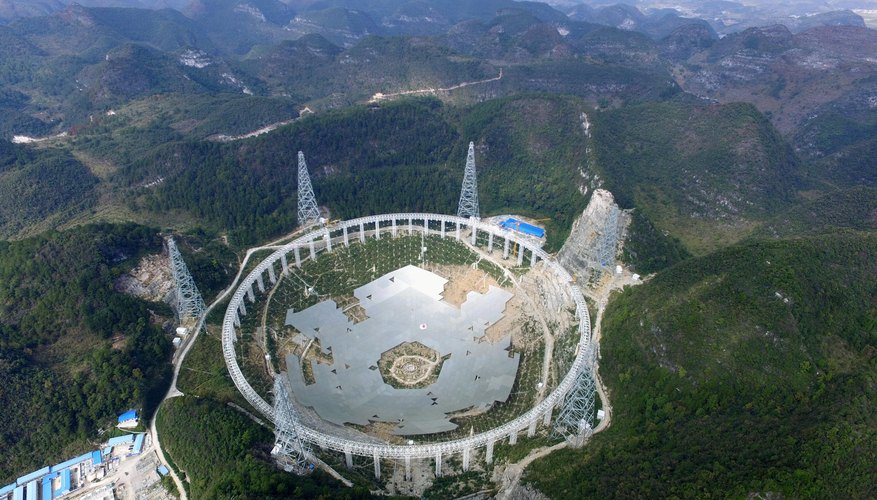
China
took a giant leap into the 21st century when it completed construction
of the world’s largest telescope in the fall of 2016. An aerial view of
the massive bowl-shaped dish aptly fits its given name – Tianyan – the
Eye of Heaven. China spent 1.2 billion yuan, $180 million USD to build
the high-tech listening device, some of which they hope to offset by
tourism.
Concept to Construction
First
conceived in 1993, the preliminary study project – the Knowledge
Innovation Project – leaped its first hurdle in October of 2001 when it
received support from the Chinese Academy of Sciences and the Ministry
of Science and Technology. It would take another six years before the
project received approval from the National Development and Reform
Commission in 2007 when it entered the feasibility study phase. A little
more than a year later, the project received the green light and the
initial design phase started. Construction began in 2011, and it took a
little over five and half years to build the high-tech telescope, now in
operation.
Bigger Than Arecibo
Situated
above traditional rural villages that dot the foothills of the Guizhou
mountains in Southwest China, more than 9,000 residents were relocated
from a nearly three-mile radius needed to operate the equipment without
radio interference. Situated in the Dawodang depression, known for its
temperate climate, water drainage, and comprised of weather-resistant
rock, the surrounding karst landscape creates an ideal location for the
telescope because the mountains protect against radio frequency
interference and keep winds down.
Almost
twice the size of the Arecibo dish in Puerto Rico, the spherical-type
Tianyan dish has a 500-meter diameter, or 1600-feet diameter. This means
the telescope is nearly five football fields in diameter laid end to
end (or could contain 30 soccer fields). The location in the Dawodang
depression allows a peak angle of 40 degrees, an opening angle of
between 100 and 120 degrees, and a 300-meter illuminated surface.
Special Features
A
special feature of the telescope allows the main reflector to correct
for spherical abnormalities on the ground, necessary for the telescope
to achieve full separation and a wide operational band without the
Chinese having to install complex mechanisms. But with additional feed
systems, the Eye to Heaven could achieve a southern zenith angle of 60
degrees, which would extend sky coverage past the galactic center.
Management and Staffing
Known
as the five-hundred-meter aperture spherical telescope, FAST, 71
scientists, technicians and site professionals currently work for the
project which began operation in September of 2016. Overseen by the
National Astronomical Observatories of the Chinese Academy of Sciences,
the telescope has already completed several missions since it went live
in September 2016.
An Ear to Heaven
While
the telescope resembles an eye, its function mimics a highly sensitive
ear because it listens to radio waves in space instead of capturing
light like the Hubble telescope does. It can separate and distinguish
the sounds it hears from the white noise background generated by stars
and pulsars in space. The radio-spectrum telescope covers a frequency
range in the 70MHz to 3GHz operational bands. The movable feed cabin for
the bowl-shaped telescope hangs from cables above the dish and serves
as the focal point for the radio waves. Because of the more than 39,000
individual panels that make up the dish surface, the telescope can
change shape to better focus the radio waves. A parallel robot and a
servomechanism creates a secondary adjustable system that allows for
high-precision tuning.
Pulsars, Dark Matter and Alien Contact
Scientific
goals and objectives for the highly sensitive telescope are
multi-pronged: search for advanced alien life – entities who might be
broadcasting radio waves into space – and map portions of the Milky Way.
So far, some of the goals for the FAST telescope include improving
sharpness of images relative to the Arecibo telescope by mapping:
- Pulsars
- Supernovae
- Black hole emissions
- Interstellar gas
Besides further enhancing what the Arecibo telescope has found, China’s scientists plan to start new searches for:
- Space’s first shining stars
- Dark matter
- Extragalactic and new galactic pulsars
- Radio signals from extraterrestrial life in conjunction with the US-based SETI organization
- Neutral hydrogen in ours and other galaxies.
Tourism: An Added Benefit
Entrance
to the telescope is free, but it costs 50 yuan, $7.20 USD, to catch a
shuttle bus ride to the site and an additional $7.20 to visit the local
astronomical museum nearby. The goal is to make China’s newest
scientific development a scenic landmark; but if you plan to visit,
schedule your visit accordingly, as only 2,000 people per day have
access to the site to avoid interfering with scientific operations.
Surpassing Scientific Achievements
With
the opening of the Eye to Heaven, China has taken massive strides in
surpassing the rest of the world’s leading scientific achievements. With
a growing technologically progressive workforce, advances in multiple
scientific disciplines, and plans to visit the moon, China currently
boasts more scientific researchers than that of the United States and is
presently outspending the European nation in scientific research and
development.






No comments:
Post a Comment